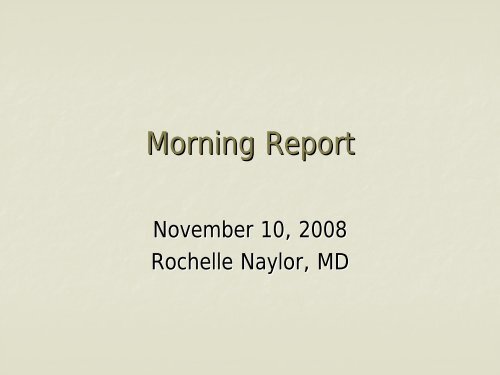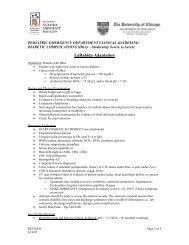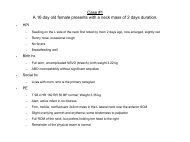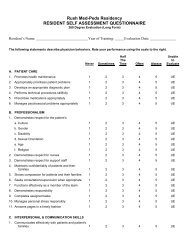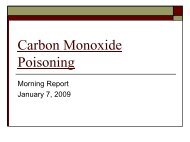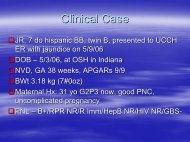Rickets
Rickets
Rickets
Create successful ePaper yourself
Turn your PDF publications into a flip-book with our unique Google optimized e-Paper software.
Morning Report<br />
November 10, 2008<br />
Rochelle Naylor, MD
Physical exam finding
Dietary deficiency<br />
Causes of rickets<br />
Dietary deficiency<br />
Vit D deficient rickets<br />
Inadequate calcium or phosphate intake<br />
Pseudovitamin D deficiency/ Vitamin D- D dependent<br />
rickets<br />
1 alpha hydroxylase deficiency<br />
<br />
dep)<br />
Mutations in the gene encoding the vitamin D receptor<br />
X-linked linked hypophosphatemic rickets<br />
Vitamin D resistance (Formerly, Type 2 vit D-dep) D<br />
Hereditary hypophosphatemic rickets with hypercalciuria
Signs and symptoms of rickets<br />
Decreased linear<br />
growth<br />
Muscular hypotonia<br />
Bone pain<br />
Delayed fontanelle<br />
closure<br />
Parietal and frontal<br />
bossing<br />
Craniotabes<br />
Rachitic rosary<br />
Harrison<br />
sulcus/groove<br />
Splayed metaphyses,<br />
wide epiphyses<br />
Bowing of femur and<br />
tibia<br />
Fractures
Radiographic findings of rickets
Radiographic findings of rickets
Vit D resistant<br />
Laboratory findings
Treatment of rickets<br />
Depends on the etiology<br />
Vitamin D deficient rickets<br />
Ergocalciferol 2,000-10,000 2,000 10,000 IU/day<br />
Calcium 1,000 mg/day
Take Home Points<br />
Vitamin D deficiency is the most common<br />
cause of rickets<br />
Vitamin D deficiency is preventable<br />
Screen high-risk high risk patients<br />
Supplement 400 IU/day beginning within the<br />
first few days of life


